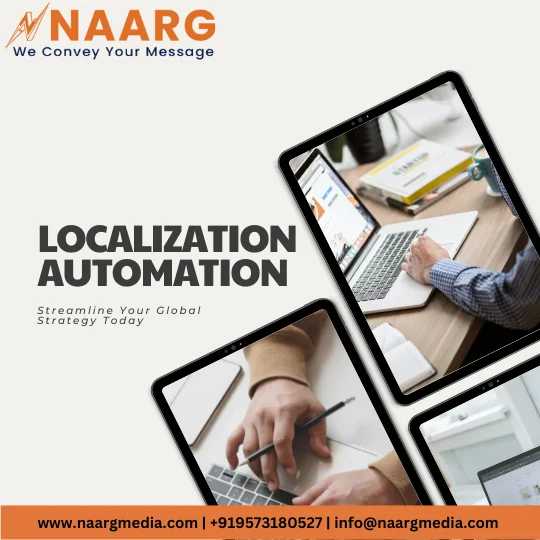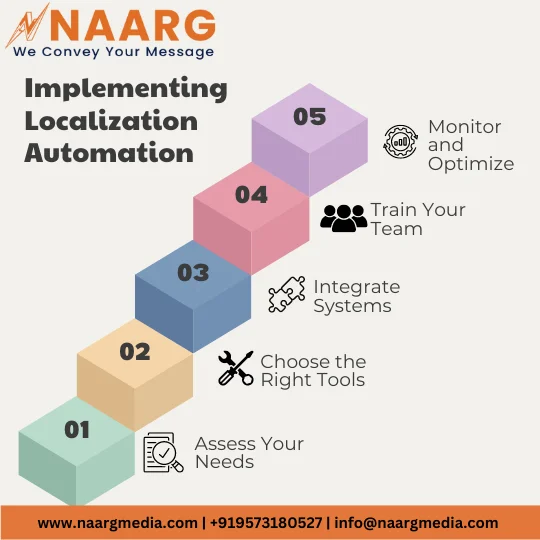In today’s global market, localization automation is more critical than ever. This advanced process ensures that content reaches diverse audiences efficiently and effectively.
Businesses can seamlessly manage their multilingual content using tools like Translation Management Systems (TMS) and machine translation.
But what exactly is localization automation, and why should your business consider it? Want to learn about localization automation.
Let’s dive in.

What is Localization Automation?
Localization automation refers to using technology to streamline adapting content for different languages and cultures. This advanced approach involves integrating localization software with content creation tools to ensure that translated content is consistent, accurate, and high-quality.
By automating repetitive tasks, businesses can significantly reduce the time and effort required for content localization. A key component of this process is the Translation Management System (TMS), which acts as a central hub for managing translation projects, tracking progress, and maintaining consistency across different languages.
Another essential tool is machine translation, which provides quick, automated translations that can serve as a first draft for human translators. Localization software plays a crucial role by integrating with other tools and systems, facilitating smooth content adaptation.
This guarantees not only the translation of the content but also its cultural relevance and engagement for the intended audience. Language Service Providers (LSP) are professional services that offer expert translations and localization quality assurance.
They work alongside automated systems to ensure the highest quality translations, leveraging their expertise to handle complex linguistic and cultural nuances. The software localization market is booming (projected at $15.6 billion by 2032, according to Allied Market Research).
Localization automation services can streamline the process, reduce costs, and get your software in front of international audiences quickly. Leverage their expertise to deliver culturally relevant experiences that win over global users.
By leveraging these tools and services, companies can achieve faster, more consistent, and more cost-effective localization. This not only enhances their global reach but also improves the user experience by delivering content that resonates with local audiences.
Key Components of Localization Automation
1. Translation Management System (TMS)
A TMS is essential for managing translation projects effectively. It acts as a central hub where all translation activities are tracked and managed. This system assigns tasks, monitors progress, and ensures consistency across different languages.
By centralizing these functions, a TMS maintains high quality and efficiency in the translation process. Businesses benefit from streamlined workflows, better resource management, and the ability to handle multiple projects simultaneously.
2. Machine Translation
Machine translation offers quick, automated translations, providing an initial draft that human translators can refine. This technology significantly accelerates the translation process, especially when dealing with large volumes of content.
By automating the initial translation phase, businesses can reduce costs associated with manual translation efforts. Although machine translation may not always capture the nuances of human language perfectly, it provides a valuable starting point.
3. Localization Software
Localization software integrates seamlessly with content creation tools, ensuring smooth adaptation of content for various markets. This software automates tedious localization tasks, such as formatting and linguistic checks, enhancing both efficiency and accuracy.
By ensuring that translated content is culturally relevant and engaging, localization software helps businesses resonate with their target audiences. The integration of these tools facilitates real-time updates and adjustments, making the localization process more agile and responsive to market needs.
4. Language Service Providers (LSPs)
LSPs bring professional expertise in translation and localization quality assurance. They handle complex linguistic and cultural nuances, ensuring high-quality translations that resonate with local audiences.
Partnering with LSPs allows businesses to leverage specialized knowledge and experience, resulting in more accurate and culturally appropriate content. LSPs provide a range of services, from translation to cultural consulting, ensuring that all aspects of content localization are covered.
5. Automated Workflows
Automated workflows streamline repetitive and time-consuming tasks such as file transfers, notifications, and updates. By automating these processes, businesses can reduce the risk of human error and enhance overall productivity.
This automation allows teams to focus on more strategic tasks that require human insight and creativity. Efficient workflows improve coordination between different departments, ensuring that localization projects are completed on time and within budget.
Automation also provides scalability, enabling businesses to handle increasing volumes of content without compromising on quality or speed. This capability is crucial for businesses looking to expand their global presence rapidly.
Advantages of Automating Localization
1. Efficiency
Localization automation significantly speeds up the process of adapting content for different markets. Automated systems handle repetitive tasks, allowing human resources to focus on more strategic and creative aspects of localization.
This results in faster project turnaround times, enabling businesses to enter new markets more quickly. The increased efficiency also reduces the workload on translation teams, allowing them to manage more projects simultaneously.
2. Consistency
Automation ensures that translations maintain a consistent tone, style, and terminology across all languages. Tools like TMS enforce adherence to terminology databases and style guides, providing uniformity in multilingual content.
This consistency enhances brand integrity and trust, as customers receive the same high-quality experience regardless of the language they use. Consistent messaging is crucial for building a strong global brand.
3. Cost-Effective
Automating localization reduces the reliance on manual labor, significantly cutting down on costs associated with human translation efforts. Machine translation and automated workflows help lower expenses by handling the bulk of the initial translation work and repetitive tasks.
This cost-effectiveness allows businesses to allocate resources more efficiently, investing in areas that require human expertise, such as cultural adaptation and quality assurance.
4. Scalability
Automated localization systems are designed to easily scale and handle increasing volumes of content as businesses grow. These systems can accommodate more languages and larger amounts of content without compromising on quality or speed.
Scalability is essential for businesses expanding into new markets, as it ensures that the localization process can keep pace with their growth and evolving needs.
5. Accuracy
Automated checks and balances integrated into localization systems minimize human error. Quality assurance tools systematically review translations for accuracy and consistency, ensuring that content is accurately localized.
This attention to detail improves the reliability and effectiveness of multilingual communications, helping businesses deliver precise and culturally appropriate content to their global audience.
Implementing Localization Automation

1. Assess Your Needs
Start by thoroughly evaluating the scope of your localization requirements. Determine the types of content that need to be localized, identify the target languages, and consider the cultural nuances that must be addressed.
This initial assessment helps in choosing the most suitable tools and strategies for your localization needs, ensuring a tailored approach that aligns perfectly with your business objectives and market demands.
2. Choose the Right Tools
Select a Translation Management System (TMS), localization software, and Language Service Providers (LSP) that best meet your specific requirements. These tools should integrate seamlessly with your existing systems and support your localization goals efficiently.
Choosing the right tools is crucial for creating a robust and effective localization workflow, enabling smooth and efficient operations that cater to your unique needs and maximize the impact of your localization efforts.
3. Integrate Systems
Ensure that the chosen localization tools integrate smoothly with your content management systems and other related platforms. Proper integration is vital for creating a seamless workflow, allowing for efficient content adaptation and minimizing the need for manual intervention.
This integration ensures that all components work together harmoniously, enhancing overall efficiency and productivity, and allowing your team to focus on higher-value tasks.
4. Train Your Team
Provide comprehensive training to your team on how to use the new tools and workflows effectively. This training ensures that everyone is familiar with the systems and can utilize them to their full potential, maximizing productivity and efficiency.
Well-trained teams are better equipped to handle localization tasks, ensuring high-quality results and a smooth transition to automated processes, which ultimately leads to improved project outcomes.
5. Monitor and Optimize
Continuously monitor the localization process and gather feedback from your team and end-users. Use this information to optimize workflows, address any issues, and enhance performance.
Regular optimization ensures that the localization process remains efficient, effective, and responsive to changing needs and market conditions. By staying proactive and making necessary adjustments, you can maintain a high level of quality and performance in your localization efforts.
Benefits of Localization Automation
1. Improved Speed to Market
Localization automation enables faster adaptation of content, leading to quicker international product launches. This speed gives businesses a competitive edge by allowing them to reach global audiences promptly.
Rapid market entry is crucial for capturing market share and responding to international opportunities effectively, ensuring that businesses stay ahead of the competition and meet the demands of diverse markets efficiently.
2. Higher Quality Translations
Automation tools ensure consistent and accurate translations through built-in quality checks. By maintaining high standards, businesses can deliver reliable and culturally appropriate content to diverse audiences.
High-quality translations not only enhance the user experience but also build trust with global customers, fostering brand loyalty and increasing the overall credibility and reputation of the business.
3. Enhanced Global Reach
Automated systems allow for efficient management of content localization across multiple regions simultaneously. This capability expands a business’s global reach, enabling it to connect with a broader audience effectively. Efficient localization processes support global growth and market penetration strategies, allowing businesses to establish a strong presence in new markets and engage with diverse customer bases around the world.
4. Increased Productivity
Automation frees your team from repetitive manual tasks, allowing them to focus on higher-value activities such as creative work and strategic planning. This boost in productivity enables better resource allocation and improves overall operational efficiency.
More efficient use of human resources leads to better outcomes and higher employee satisfaction, as teams can dedicate their efforts to more impactful and rewarding tasks.
5. Better User Experience
Delivering culturally relevant and engaging content enhances the user experience. Localization automation ensures that content resonates with local audiences, fostering stronger connections and improving customer satisfaction.
A better user experience translates to increased loyalty, higher engagement, and ultimately, better business performance. By providing content that is tailored to the needs and preferences of different markets, businesses can build lasting relationships with their customers.
Localization automation is transforming how businesses approach global expansion. By integrating advanced tools like Translation Management Systems (TMS), machine translation, and localization software, companies can achieve greater efficiency, consistency, and quality in their multilingual content.
The benefits of automating localization are clear, from improved speed to market to enhanced global reach.
Ready to take your business to the next level? Embrace localization automation today and streamline your global strategy.
Naarg Data Media Services is a proven translation service provider providing support to all clients with the best results in various domains.
We at Naarg strive to serve professional translation and localization services to all our clients across the globe.
Contact us today to know more about our services.

